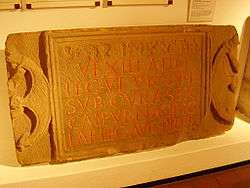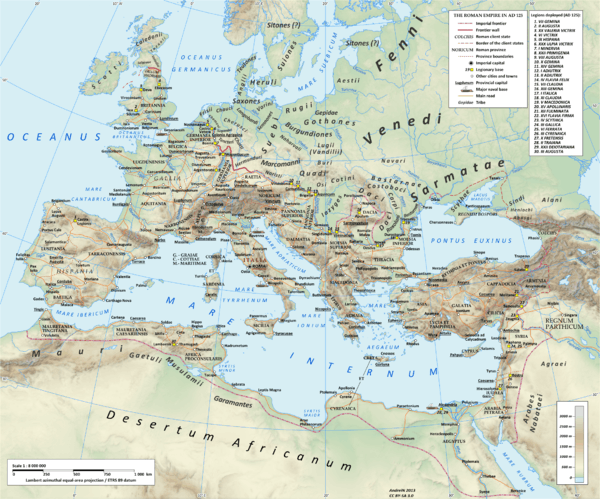Legio VI Victrix
| Legio VI Victrix | |
|---|---|
|
| |
| Active | 41 BC to after 2nd century |
| Country | Roman Republic and Roman Empire |
| Type | Roman legion (Marian) |
| Role | Infantry assault (some cavalry support) |
| Size | Varied over unit lifetime. |
| Garrison/HQ | Perusia (41 BC) |
| Nickname(s) | Victrix, "Victorious" |
| Engagements |
Perusia (41 BC) Cantabrian wars (29-19 BC) |
| Commanders | |
| Notable commanders | Servius Sulpicius Galba |
 | ||||
| Part of a series on the | ||||
| Military of ancient Rome | ||||
|---|---|---|---|---|
| Structural history | ||||
|
||||
| Campaign history | ||||
| Technological history | ||||
|
||||
| Political history | ||||
|
|
||||
| Strategy and tactics | ||||
|
||||
|
| ||||
Legio sexta victrix ("Victorious Sixth Legion") was a legion of the Imperial Roman army founded in 41 BC by the general Octavian (later known as the emperor Augustus). It was the twin legion of VI Ferrata and perhaps held veterans of that legion, and some soldiers kept to the traditions of the Caesarian legion.
In Republican Service
The legion saw its first action in Perusia in 41 BC. It also served against the Sextus Pompeius, who occupied Sicily and made threats to discontinue sending grain to Rome. In 31 BC the legion fought in the Battle of Actium against Mark Antony.
In Imperial Service
VI Victrix in Spain
The legion took part in the final stage of the Roman conquest of Hispania, participating in Augustus' major war against the Cantabrians, from 29 BC to 19 BC,[1] that brought all of the Iberian Peninsula under Roman rule.
The legion stayed in Spain for nearly a century and received the surname Hispaniensis, founding the city of Legio (modern-day León).[2] Soldiers of this unit and X Gemina numbered among the first settlers of Caesaraugusta, what became modern-day Zaragoza. The cognomen Victrix (Victorious) dates back to the reign of Nero. But Nero was unpopular in the area, and when the governor of Hispania Tarraconensis, Servius Sulpicius Galba, said he wished to overthrow Nero, the legion supported him and he was proclaimed Emperor in the VI Victrix legionary camp. Galba created VII Gemina and marched on Rome, where Nero killed himself.
VI Victrix in Britain


In 119, Hadrian relocated the legion to northern Britannia, to assist those legions already present in quelling the resistance there. Victrix was key in securing victory, and would eventually replace the diminished IX Hispana at Eboracum.[3] In 122 the legion started work on Hadrian's Wall which would sustain the peace for two decades.
Twenty years later, they helped construct the Antonine Wall, but it was largely abandoned by 164.
In 175, the Roman emperor, Marcus Aurelius, defeated the Iazyges tribe of Sarmatians. He took them into Roman service and settled 5,500 of them in Britain; some were assigned to the VI Legion Victrix based in York and others are attested in a unit at Ribchester, south of Lancaster.
In 185, the British legions mutinied and put forward a commander of their own, named Priscus, to replace the unpopular Emperor Commodus, but the former declined. The mutiny was suppressed by Pertinax, who would later become emperor himself after Commodus was murdered.
The Legate of the legion in the late second century, Claudius Hieronymianus, dedicated a temple to Serapis in Eboracum in advance of the arrival of Septimius Severus in AD208.[4]
An altar to Hercules was dedicated by Gaius Vitellius Atticianus, Centurion of the Legio VI Victrix, at Whitley Castle (Epiacum).[5]
epigraphic inscriptions
- - Dis Manibus Gai Iuli Galeria tribu Caleni Lugduno veterani ex legione VI Victrice Pia Fideli heres a se memoriae fecit. Lincoln (Lindum), U.K. RIB 252 = CIL VII 182.
- - Dis Manibus sacrum Nig̣ṛiṇae vixit annos XXXX Aurelius Casitto legionis VI Victricis Piae Fidelis curavit. Great Chesters (Aesica), U.K. RIB 1746 = CIL VII 740.
- - Dis Manibus Titi Flavi Flavini legionis VI Victricis Classicius Aprilis heres prius quam obiret
fieri iussit. York (Eboracum), U.K. RIB 675.
- - Dis Manibus Lucius Bebius Augusta (tribu) Crescens Vindelicum miles legionis VI Victricis Piae Fidelis annorum XLIII stipendiorum XXIII heres amico faciendum curavit. York (Eboracum), U.K. RIB 671.
- - Dis Manibus Flaviae Augustinae vixit annos XXXVIIII menses VII dies XI filius Saenius Augustinus vixit annum I dies III vixit annum I menses VIIII dies V Gaius Aeresius Saenus veteranus legionis VI Victricis coniugi carissimae et sibi faciendum curavit. York (Eboracum), U.K. RIB 685 = CIL VII 245.
- - Dis Manibus Gaius Iulius Gai filius colonia Flavia Ingenuus miles legionis VI Victricis Piae Fidelis. High Rochester (Bremenium), U.K. RIB 1292 = CIL VII 1057.
- - Dis Manibus Flavius Agricola miles legionis VI Victricis vixit annos XLII dies X Albia Faustina coniugi inconparabili
faciendum curavit. London (Londinium), U.K. CIL V 25.
- -Lucio Pompeio Luci filio / Quirina (tribu) Faventino / praefecto cohortis VI Asturum / tribuno militum legionis VI Victricis (...). Astorga (Asturica), Spain. CIL II 2637 = AE 1966, 187.
- - Lucius Valerius Silvanus / miles legionis VI Victricis / Deo Turiaco / votum solvit libens merito. Porto (Portus), Portugal. CIL II 2374 = AE 1959, 103. ·
- - Titus Pompeius Titi filius / Tromentina (tribu) / Albinus' domo Vienna / IIvir tribunus militum legionis VI Victricis. Mérida (Emerita Augusta), Spain. AE 2002, 929.
- - Dis Manibus sacrum Gaius Iulius Severus veteranus legionis VI Victricis annorum LXI Iulia Danae liberta ex testamento (...).Mérida (Emerita Augusta), Spain. CIL II 490.
- - Marcus Tavonius / Marci filius / Romilia (tribu) / Firmus domo Ateste / miles legionis VI Victricis (...). Mérida, Spain. Museo Nacional de Arte Romano - Mérida.
- - Dis Manibus sacrum / Gaius Iulius Severus / veteranus legionis VI Victricis / annorum LXI / Iulia Danae liberta ex testamento (...). Mérida, Spain. CIL II 490.
- - Dis Manibus sacrum Lucius Maelonius Aper veteranus legionis VI Victricis Piae Fidelis annorum LXX militavit beneficiarius (...). Mérida, Spain. CIL II 491.
- - Dis Manibus sacrum / Lucius Maelonius Aper / veteranus legionis VI Victricis Piae Fidelis annorum LXX / militavit beneficiarius (...). Mérida, Spain. CIL II 491.
- - Legio VI victrix. Moers, Nordrhein-Westfalen. AE 2005, 1069b.
- - Lucius Helvius Luci filius / Papiria tribu / Rebilus Augustanus / veteranus legionis VI Victricis. Mérida, Spain. AE 2006, 616.
In Popular Culture
The legion is mentioned in Robert Heinlein's novel Have Space Suit - Will Travel. and in the book From Scythia to Camelot By C. Scott Littleton and Linda A. Malcor
Reenactment
A modern reenactment group based in Los Angeles reenacts this legion.
Legio VI Victrix, Eboracum reenacts this legion in York.
See also
References
- ↑ Rabanal Alonso, Manuel Abilio (coord.) (1999). La Historia de León, Vol. 1: Prehistoria y Edad Antigua (in Spanish). Universidad de León. p. 133. ISBN 84-7719-817-9. Retrieved 18 November 2013.
- ↑ Rabanal Alonso, Manuel Abilio (coord.) (1999). La Historia de León, Vol. 1: Prehistoria y Edad Antigua (in Spanish). Universidad de León. p. 189. ISBN 84-7719-817-9. Retrieved 18 November 2013.
- ↑ Nitze, William A. (August 1941). "Bedier's Epic Theory and the "Arthuriana" of Nennius". Modern Philology. 39 (1): 1–14. doi:10.1086/388502. JSTOR 434162. This states that VI Victrix was based at Eburacum (York).
- ↑ De la Bedoyere, G. 2002. Gods with Thunderbolts: Religion in Roman Britain. Tempus, Stroud. pp174.
- ↑ Robertson, Alastair F. (2007). Whitley Castle; Epiacum: A Roman Fort near Alston in Cumbria (3rd ed.). Hundy. pp. 22–23. ISBN 978-0-954-73394-0.
External links
| Wikimedia Commons has media related to Legio VI Victrix. |
- livius.org account
- Legion Six Victorious, Los Angeles Roman reenactment society
- LEG VI VIC COH VI ASTVR, German re-enactment society
- The Antonine Guard, Scottish re-enactment society
- History Files: Alans (Geloni)
- From Scythia to Camelot By C. Scott Littleton and Linda A. Malcor
